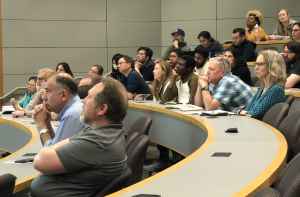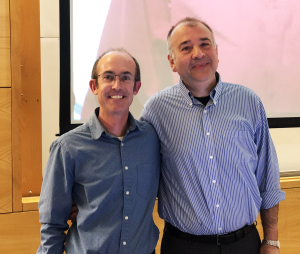
Neurobiologist Ryan Hibbs delivered an Apex Lecture to School of Medicine Basic Sciences faculty, students, and postdocs on March 27, 2025. Hibbs is the chair of the Department of Neurobiology and a professor of pharmacology in the School of Biological Sciences at the University of California, San Diego. His talk focused on muscle acetylcholine receptors in development and disease.The Hibbs lab researches the fine details of fast communication in the nervous system, how this signaling goes awry in disease, and how drugs alter it. In his lecture, Hibbs highlighted current work from his lab that investigates how connections between our nervous system and skeletal muscle develop, and how, in cases of autoimmune disease, these junctions are attacked. He described how his lab purifies micrograms of muscle receptor protein from kilograms of bovine—beef—muscle to yield high-resolution structures of the acetylcholine receptor. Acetylcholine is a neurotransmitter that plays a crucial role in various bodily functions such as muscle contraction and memory, and its dysregulation can lead to various disorders. Certain medications that target acetylcholine can be used to treat these conditions.
 Hibbs then touched on the structural and functional properties of antibodies that target muscle receptors, particularly those involved in myasthenia gravis, an autoimmune disease. Myasthenia gravis causes muscle weakness that often starts with ocular symptoms and progresses to respiratory failure.
Hibbs then touched on the structural and functional properties of antibodies that target muscle receptors, particularly those involved in myasthenia gravis, an autoimmune disease. Myasthenia gravis causes muscle weakness that often starts with ocular symptoms and progresses to respiratory failure.
In the second part of the talk, Hibbs focused on myasthenia gravis, describing how his lab is using structural and functional methods to map epitopes for pathogenic patient antibodies and understand the mechanisms underlying the disease. Ultimately, they hope to identify antibody binding sites and their mechanisms of action, and develop targeted therapies for the disease.
Hibbs noted how antibodies found in people with myasthenia gravis can bind to muscle receptors in different ways. The antibodies bind to the receptor at a variety of places and angles, and vary in how many antibodies can bind a receptor at once. Hibbs’s lab looked at six different antibodies from myasthenia gravis patients and found that they bind to distinct locations on the receptor but also share some common binding sites. Importantly, all of the antibodies his lab examined could directly interfere with the function of the receptor by blocking its ability to open and allow the flow of ions.

Hibbs ended his talk by explaining how understanding the detailed structures of how these antibodies bind can help predict the ways they might cause problems in the body and lead to the symptoms of myasthenia gravis. These investigations can hopefully provide insights into the potential mechanisms by which the autoimmune response causes the muscle weakness seen in myasthenia gravis.
After his lecture, Hibbs joined attendees in the MRB III atrium for a reception.